In 2024, remote work is no longer a new concept, but that doesn’t mean we’ve mastered it — or the remote work software we’ve chosen.
The 2020s began with 57% of companies working fully remote due to the COVID-19 pandemic. Now, just 16% of companies work fully remote in 2024 — but 83% of the global workforce finds hybrid work ideal.
In other words, remote work wasn’t just a fad. While no longer at the unprecedented peak it hit in the 2020s, remote and hybrid work has become a fundamental component of the modern work environment. That means you’ll need the right tools to be successful.
Fortunately, we have you covered. Check out our list of the 10 best remote work software options you need in 2024.
- 1. Hubstaff – for all-in-one remote workforce management
- 2. Google Drive – for cloud storage and document collaboration
- 3. Slack – for real-time communication
- 4. Todoist – for tracking to-dos
- 5. Workleap – for performance management
- 6. Loom – for recording video walkthroughs
- 7. Dialpad – to get the most out of your meetings
- 8. Asana – for efficient project management
- 9. LastPass – for better password management
- 10. Notion – for internal documentation
- 11. Zoom – for video calls
- Next steps for remote work software
Boost your team’s efficiency with Hubstaff's productivity tools
1. Hubstaff – for all-in-one remote workforce management
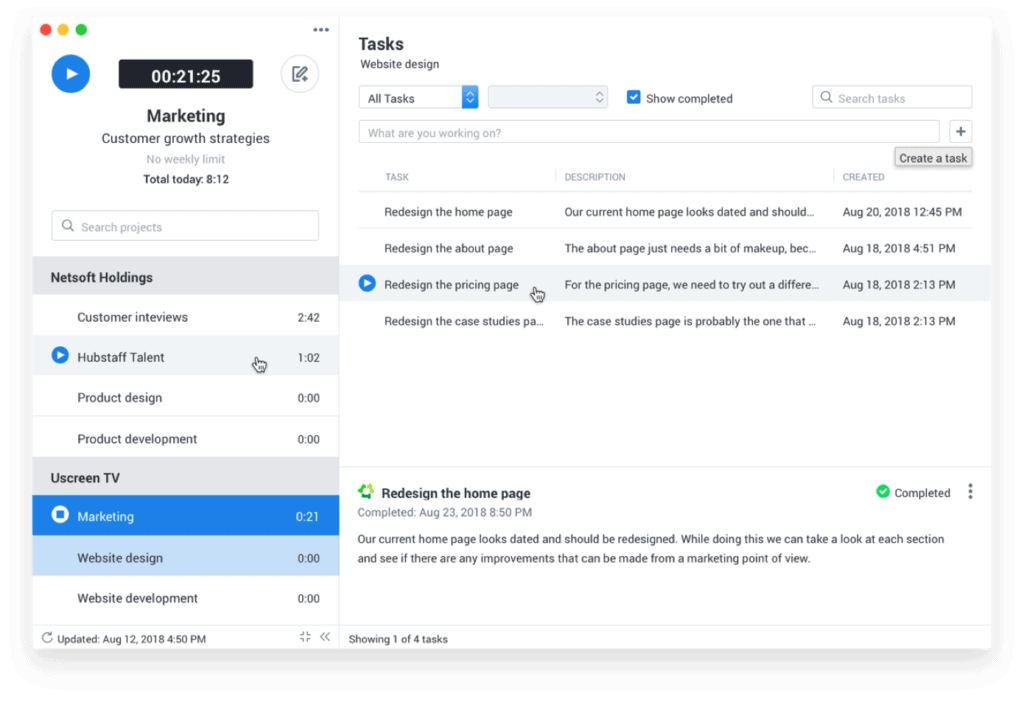
Okay, we’re a bit biased, but we’re seasoned remote experts here at Hubstaff. Our remote workforce management software was created with the sole intention of helping remote teams manage time tracking, payroll, and employee productivity for teams of all sizes.
Key features
- Time tracking. Intuitive time tracking helps employees create their own timesheets at the click of a button — and without missing a second. Track time on Mac, Windows, iOS, Android, or even Google Chrome.
- Payroll management. What good are timesheets if you can’t pay your team, right? Fortunately, Hubstaffs native payroll system can help. That said, if you have a favorite payroll provider, you can choose one of your favorite payment integrations to process payroll instead.
- Productivity. The big knock on remote work is that it’s hard to know if employees are working. That’s why Hubstaff’s productivity tracking feature gives users and managers real-time updates on mouse and keyboard movements and website and app usage. You can also gauge utilization rates to reduce burnout and increase employee engagement.
- Integrations. Hubstaff has 30+ integrations with your favorite tools for project management, accounting, customer support, and more.
Pricing
- Free plan
- Starter: $7 per user/month
- Grow: $9 per user/month
- Team: $12 per user/month
- Enterprise: $25 per user/month (annual pricing only)
Need more advanced features? Hubstaff also offers extra add-ons that boost its primary team management features:
- Tasks ($3 per user/month)
- Insights ($2 per user/month)
- More screenshots ($3 per user/month)
- Corporate add-on ($3 per user/month)
2. Google Drive – for cloud storage and document collaboration
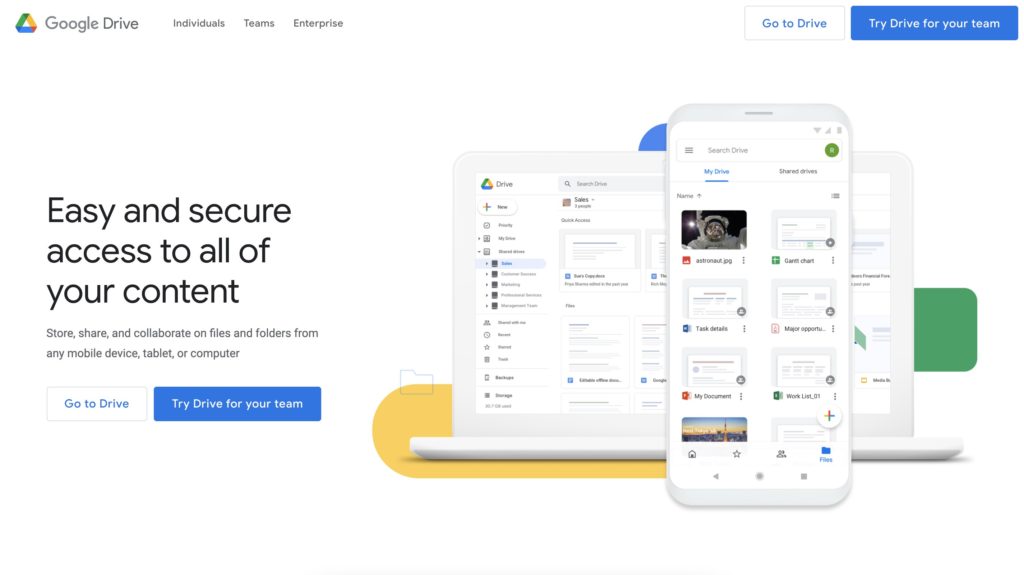
If you still keep work-related files on your local computer, you’re playing with fire. While it makes our list mainly for providing a space for remote teams to share and collaborate on their work, even in-office can benefit from the security safe haven that is Google Drive.
Drive is your one-stop shop for document and file sharing for remote teams of all sizes. It might not be the most flashy and exciting of the tools on our list, but it’s the backbone of the modern workforce with over 2 billion people using it.
Key features
- Cloud file storage and sharing
- Document processing
- Spreadsheets
- Remote collaboration
- Presentations
User reviews
G2: 4.4/5
Capterra: 4.8/5
Pricing
- Personal use: Free 15 GB for personal users
- Business: $12 per user/month paid annually
Google One also gives you larger storage options:
- 100 GB ($1.99/month)
- 2 TB ($9.99/month)
- 2 TB AI Premium ($19.99/month)
3. Slack – for real-time communication
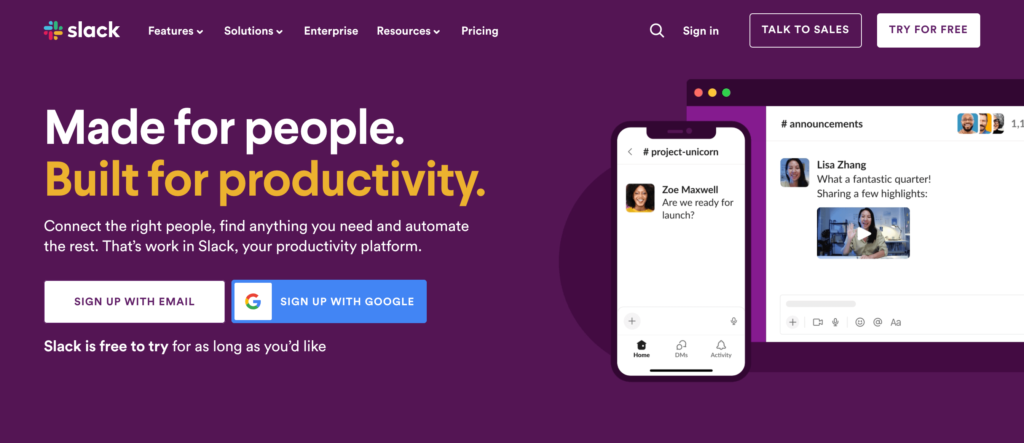
Like Google Drive, Slack is the way of the modern workforce regardless of whether you work remotely, in-office, or hybrid. This modern communication savior leaves email in it’s dust with an intuitive interface and helpful features for remote teams of all sizes.
Key features
- Channels
- Direct messaging
- Huddles (Audio and video calls)
- Message search
- File sharing
- Integrations with your favorite tools
Pricing
- Pro: $7.25 per user/month. Unlimited message history, integrations, workflows, group audio and video meetings, and messaging with users outside of your organization.
- Business+: $12.50 per user/month. All the features of Pro but with double the workflows for growing businesses.
- Enterprise Grid: Slack’s enterprise business plan with unlimited workspaces, AI add-ons, and more. Contact sales for more information.
4. Todoist – for tracking to-dos
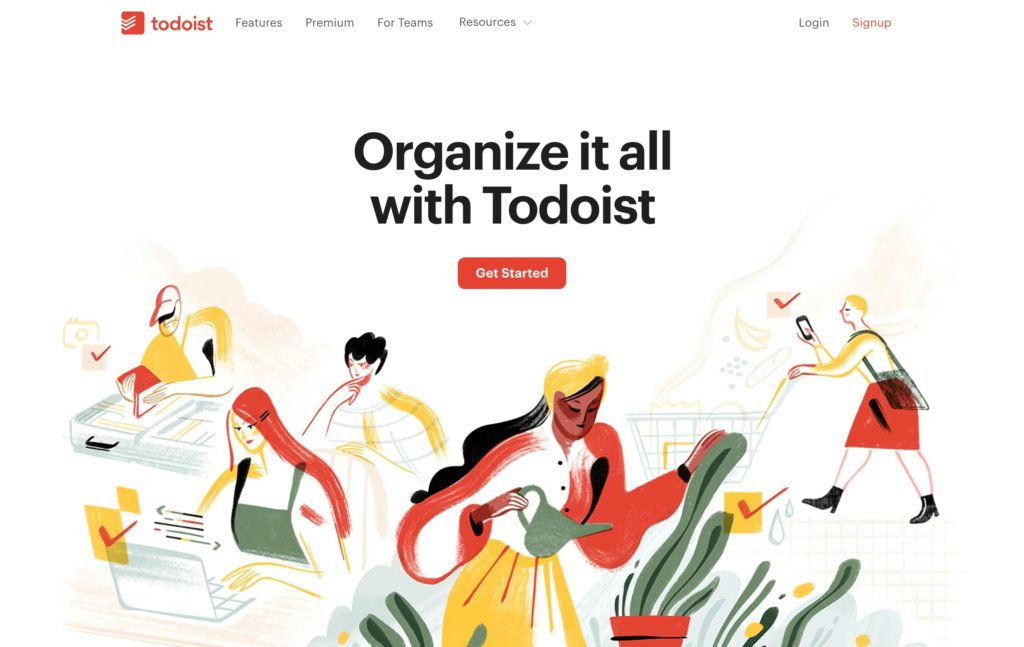
The big knock on remote work is that remote workers lack the discipline to avoid life’s distractions when working from home or on the go. I hate to admit it, but it’s sometimes true.
Fortunately, tools like Todoist ensure you complete everything on your to-do list before you indulge in the pleasures of remote work. Recurring due dates, reminders, and even a priority system help you plan and execute on your to-dos with relative ease.
Key features
- To-do lists
- Recurring due dates
- Reminders
- Priorities and labeling
- Subtasks
- 80+ integrations
Pricing
- Beginner: Free for productivity novices. Includes 5 personal projects, flexible lists and board layouts, and a one week activity history.
- Pro: $4 per user/month for 300 personal projects, calendar view, 150 filters, and more.
- Business: $6 per user/month up to 500 team projects, team calendars, and more.
5. Workleap – for performance management

Even with workforce management tools like Hubstaff to gauge workloads, remote teams have an uphill battle in ensuring that each and every employee has access to the tools they need to be at their best mentally and emotionally.
Fortunately, Workleap’s Officevibe is a remote work software that offers exactly that. This Human Resources/People Operations platform puts the onus on employee well-being with one-on-ones, surveys, and more.
Key features
- Pulse surveys
- Survey reports
- 1-on-1 meetings
- Anonymous feedback
Pricing
- Free: 1 month of data history, Pulse Survey, one-on-ones, Goals & OKRs, and basic integrations
- Essential: $5 per user/month for everything in free plus unlimited data history and teams, focus areas, action plans, team and industry benchmarking, and more.
- Pro: $8 per user/month for onboarding surveys for everything in essential plus onboarding and DEIB surveys, data exports, AI feedback analysis, and more.
6. Loom – for recording video walkthroughs
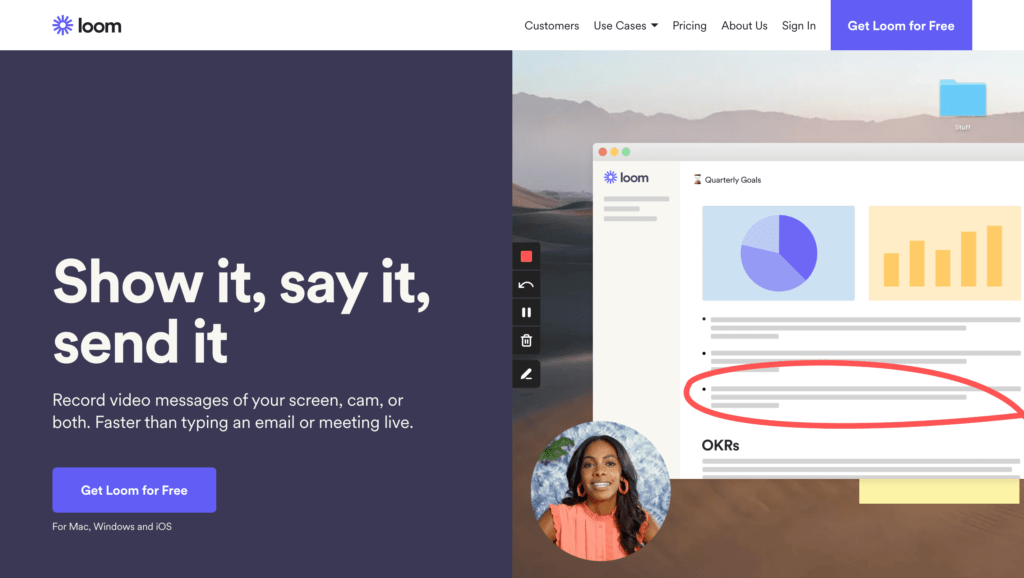
The true power of remote work lies in its asynchronous potential. Loom embodies what it means to work remote with AI-powered messaging that helps teams work across multiple time zones.
With Loom, you’ll never need to worry about uniting your global team for every call or onboarding team members located overseas. You can use it to record your computer screen to create tutorials, intros for new hires, project updates, and more with relative ease. It’s available for desktop, Chrome, and iOS, so you can make videos anytime and anywhere.
Key features
- Screen and webcam recording
- Video drawing tool
- Calls-to-action
- Custom branding
- Reports
Pricing
- Free: Up to 25 videos per person at five minutes a piece.
- Business: $12.50 per user/month for unlimited videos and recording length
- Enterprise: Unlimited videos and recording length, Salesforce add-ons, and more. Contact sales for custom plans.
7. Dialpad – to get the most out of your meetings
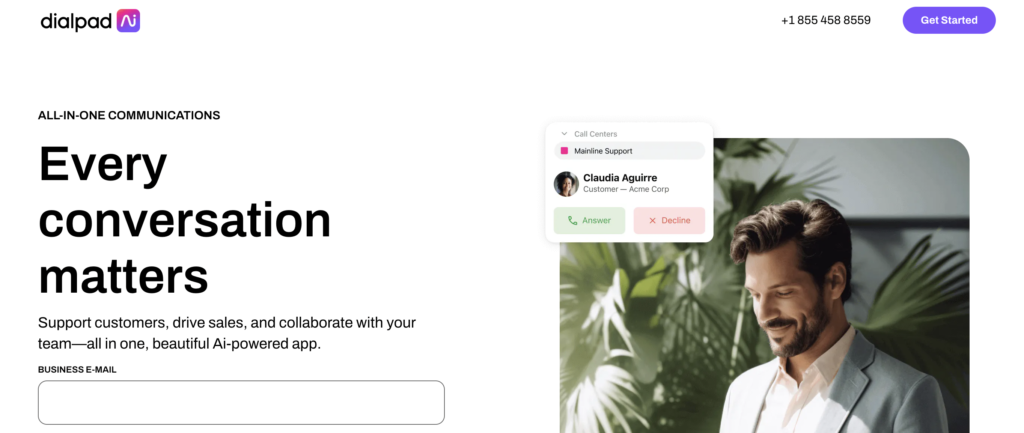
Dialpad empowers remote team members by providing a comprehensive cloud-based communication solution. With features like voice and video calling, messaging, and conferencing, Dialpad ensures seamless collaboration regardless of geographical distances. Its intuitive interface and integration capabilities make it a valuable tool for remote teams, offering the flexibility and connectivity needed to thrive in the digital workspace.
Key features
- Voice and Video Calling
- Messaging
- Conferencing
- Voicemail and Call Recording
Pricing
- Standard: $15 per user/month for unlimited calling, AI meetings (up to 10 participants), real-time analytics, and more.
- Pro: $25 per user/month for 24/7 live support, CRM integrations, multiple phone numbers per account, and more.
- Enterprise: Contact Dialpad for enterprise pricing.
8. Asana – for efficient project management
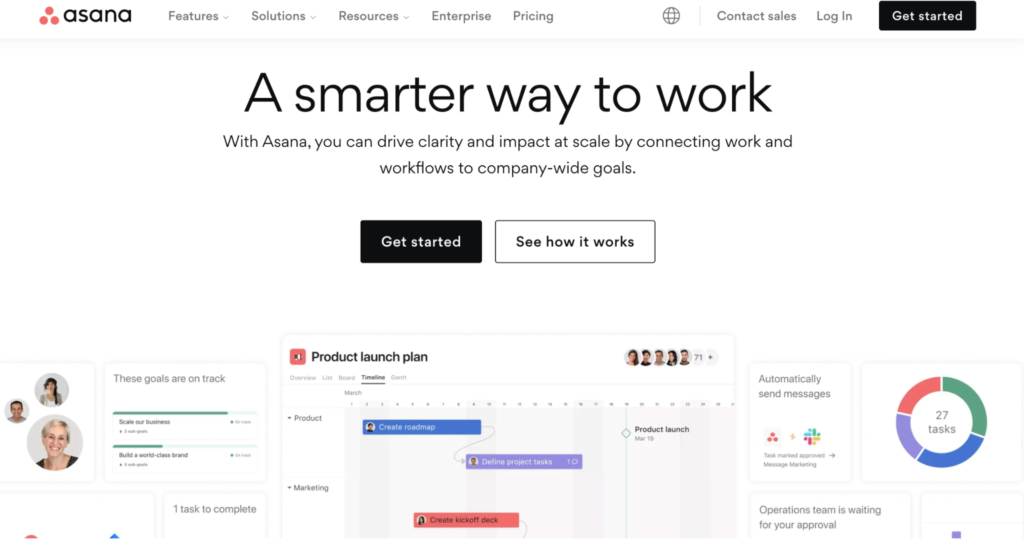
Asana would be much higher on our list, but it felt like cheating to put a great all-around project management tool so high on a list of remote work software. It is true though: Asana is one of the best project management tools on the market for remote, hybrid, or in-office teams.
You can create projects, seamless shift between popular project management views, and create rules to automate workflows and keep your team on task — no matter where they are in the world.
Key features
- Project and task management. Create tasks, assign your team, and start building workflows. You can also break tasks into subtasks and create rules to automate how work moves across each step of the process.
- Project views. Unlike most project management tools, Asana really can help you shift seamlessly across popular project management views. Whether you’re a Gantt chart, Kanban, Calendar fan, or all of the above, Asana helps you switch gears seamlessly and allows teams to visualize their work anyway they like without it impacting their teammates.
- Integrations. Asana works seamlessly with dozens of tools like Google Drive, Slack, Dropbox, and even Hubstaff.
Pricing
- Personal plan: Free
- Starter: $10.99
- Advanced: $24.99
- Enterprise: Contact Asana for pricing
9. LastPass – for better password management

LogMeIn’s password manager LastPass has long been a go-to tool for growing teams. With remote work, password encryption becomes increasingly crucial.
LastPass’ password vault approach helps you cut down on password resets for your entire team without risking security breaches from sending passwords over Slack, email, or other communication channels.
Key features
- Password storage
- Password sharing
- Shared folders
- Multifactor authentication
- SSO (for Business plan only)
Pricing
- Teams: $4 per user/month (billed annually) for private vaults (per user), shared folders, MFA, and more for up to 50 users.
- Business: $7 per user/month for unlimited users, 3 SSO apps (with MFA), 100+ customizable policies, and more.
10. Notion – for internal documentation
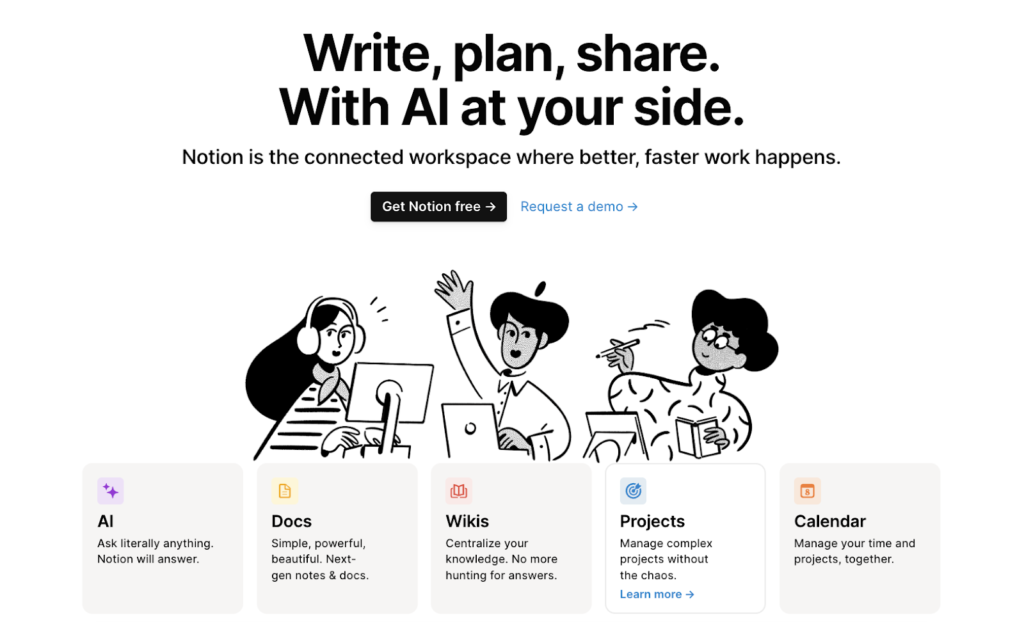
For remote teams, we don’t always have the luxury of company-wide town halls, meetings, or formal training sessions. Fortunately, we have Notion to help us document processes asynchronously so we don’t have to coordinate across timezones and departments to unveil new policies.
Key features
- Wikis: Notion is probably best known for being your one-stop knowledge hub. You can keep process documentation, onboarding checklists, and anything else you need in one centralized place to ensure employees have access no matter who is online.
- Notion AI: Think ChatGPT but built right into your company’s knowledge base. Not a bad added perk for remote employees that often work different hours than their managers.
- Projects: Manage your projects right from Notion so you never have to leave your knowledge base. Calendars round out a tool that’s becoming increasingly more project management-driven.
Pricing:
- Free: $0
- Plus: $10 per user/month (billed monthly)
- Business: $15 per user/month (billed monthly)
- Enterprise: Contact Notion for custom pricing
11. Zoom – for video calls
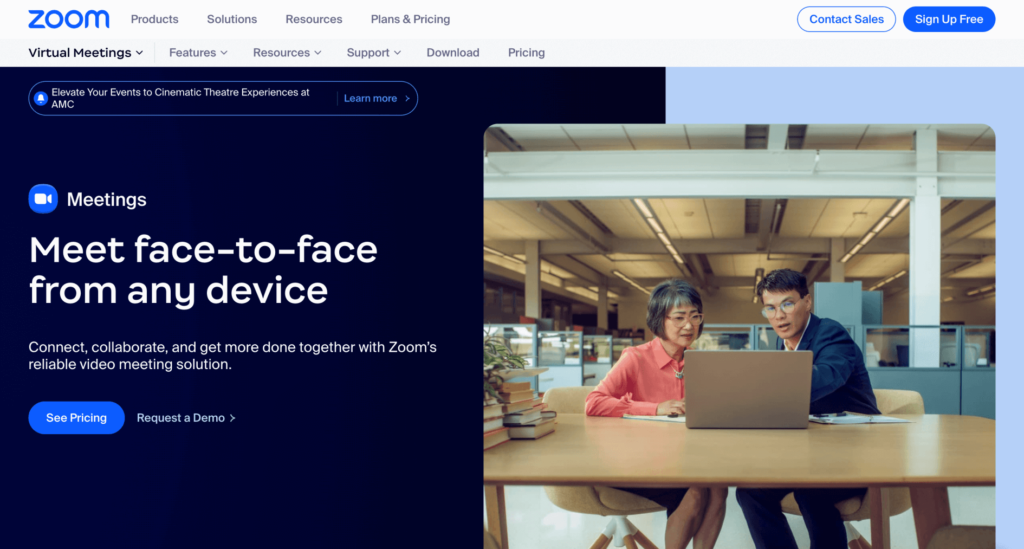
Last but not least, a familiar name in remote work software is Zoom. Zoom has made considerable strides to outgrow their basic video conferencing moniker. With Zoom Workplace, you can improve productivity and engagement for your remote team with AI-driven technology.
Key features
- Meetings
- Team chat
- Phone
- Workvivo employee engagement
- Surveys
- Docs
- Scheduling
Pricing
- Basic: Free platform for basic meeting needs. Offers 40-minute meetings with up to 100 attendees per meeting.
- Pro: $15.99 billed monthly. Everything in Free plus up to 30 hour meetings, mail and calendar, AI companion, cloud storage, and more.
- Business: $21.99 billed monthly. Everything in Pro plus 300 attendees, whiteboards, and the new scheduler feature.
- Business plan: $26.99 billed monthly. Everything in business plus 100GB of cloud storage, phone, visitor management, and more.
- Enterprise: 1000 attendees per meeting, unlimited cloud storage, rooms, and webinars. Contact for Zoom for pricing information.
Next steps for remote work software
Have any of the tools listed piqued your interest? Here’s what you need to do next:
- Identify challenging activities: Consider which remote activities are currently tricky or time-consuming. Is it project management, communication, or something else? Use remote work software to make these activities easier.
- Start free trials: Most of the remote work software on our list offers a free trial. Use these trials to see if a particular tool is the right fit for you.
- Implement valuable tools into your workflow: Once you see which tools work for you, implement them into your workflow and make it easier for yourself or your team to work remotely.
Interested in more content on remote work? Check out these posts:
Most popular
The Fundamentals of Employee Goal Setting
Employee goal setting is crucial for reaching broader business goals, but a lot of us struggle to know where to start. American...
Data-Driven Productivity with Hubstaff Insights: Webinar Recap
In our recent webinar, the product team provided a deep overview of the Hubstaff Insights add-on, a powerful productivity measurem...
The Critical Role of Employee Monitoring and Workplace Security
Why do we need employee monitoring and workplace security? Companies had to adapt fast when the world shifted to remote work...
15 Ways to Use AI in the Workforce
Whether through AI-powered project management, strategic planning, or simply automating simple admin work, we’ve seen a dramatic...





